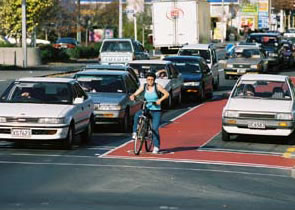
Very few audited intersections had special provisions for cyclists. Consider the following factors:
These factors should not determine whether an improvement is needed, as all signalised intersections should work for cyclists. Rather, the factors simply help determine which should be fixed first (adapted from US Department of Transportation, 1998).
As intersections are inherently more difficult to negotiate for cyclists, it is desirable to allow for them at intersections even when there are no connecting mid-block cycle facilities.
The key planning principle relates to the provision of adequate space for cyclists.
The following safety and efficiency issues can arise from missing or deficient cycle facilities at signalised intersections:

Figure 19 No safe and legal waiting position for
straight-through cyclists during left-turnonly phase

Figure 20 A good example of providing for cyclists
at
traffic signals